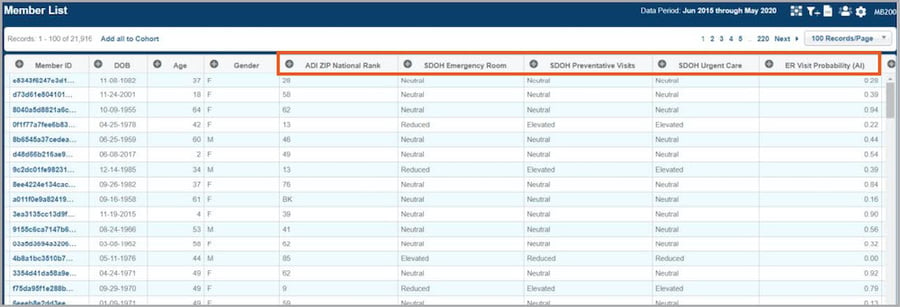Deerwalk Plan Analytics Version 10.1 Introduces Social Determinants of Health Data & A New Machine Learning Model for ER Visit Prediction
Deerwalk's latest release makes SDOH data available along with a model that predicts the likelihood a member will visit the ER

Below are the key highlights from this month’s release of Deerwalk Plan Analytics:
- SOCIAL DETERMINANTS OF HEALTH: AREA DEPRIVATION INDEX
- NEW MACHINE LEARNING MODEL: ER VISIT PREDICTION
- CREATE MODULE ENHANCEMENTS
1. SOCIAL DETERMINANTS OF HEALTH: AREA DEPRIVATION INDEX
We’ve integrated the Area Deprivation Index (ADI), a new data set, into our data scrub process to provide you with enriched data that's accessible via both the Member Search Module and the Create Module. Since the ADI value is generated using ZIP codes from an eligibility file, it can give insight into the healthcare risks of a new population whose previous health history is unknown due to a lack of available data.
- The “ADI ZIP National Rank” field uses the ADI proposed by the University of Wisconsin, which ranks ZIP codes by their socioeconomic status disadvantage.
- A lower rank represents a greater relative advantage and a higher rank represents a greater relative disadvantage in terms of the expected healthcare behavior for residents of that ZIP code.
- We’ve incorporated three new fields that show strong correlations between the ADI value for a member and their expected healthcare behavior, including “SDOH Emergency Room,” “SDOH Preventative Visits,” and “SDOH Urgent Care.” Each of these fields displays a value of “Reduced,” “Neutral,” or “Elevated” to indicate the likelihood that members within a certain ZIP code will utilize these services.

2. NEW MACHINE LEARNING MODEL: ER VISIT PREDICTION
We’ve released the Emergency Room (ER) Visit Prediction Model (see image above) to help you identify opportunities to better manage and plan for ER visits within your population(s). The model uses a series of member-specific measurements (including the ADI value) to predict the likelihood a member will visit the ER within the next year and then generates a probability score for each member. The “ER Visit Probability (AI)” field can be accessed via the Member Search and Create Modules.
- This field value is specific to an individual member’s clinical history and health condition(s).
- A probability score greater than 0.5 indicates a member is likely to have an ER visit within the next 12 months while a score lower than 0.5 indicates a member is not likely to have an ER visit.
- The existing “ER Visit Probability” field derived from the MARA model will continue to be available within the application.
3. CREATE MODULE ENHANCEMENTS
As we're always working to improve and expand upon our custom report and dashboard creation functionality, we’ve made several updates to the Create Module (including updates that affect Create Tables, Create Charts, and Create Widgets). We've added the following:
- New values that give you the ability to compare results over different time periods.
- New widget templates that allow you to include more information in the widgets you create for use in building dashboards.
- The option to relabel the display names for specific fields so you can customize your tables and charts.
- A new dumbbell chart type that comes in helpful when comparing values in reporting and comparison periods.
- The option to include utilization counts (a total count of each member's admissions, ER visits, office visits, and urgent care visits) and "Period Member Paid" and "Period Member Billed" amounts in reporting via the Create Module (these fields are also now available in the Member Search Module).
- The option to incorporate lab data real-time into the Create Module for use in reporting.
Schedule a demo to learn more about how to use Deerwalk Plan Analytics and the latest features.
Subscribe to our blog or follow us on Facebook, Twitter or LinkedIn to join the conversation.



